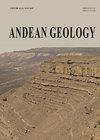追踪安第斯山脉的热点踪迹
IF 1.2
4区 地球科学
Q3 GEOLOGY
引用次数: 0
摘要
南美洲板块下方纳斯卡板块的两个俯冲段,根据地震震中位置,角度较小,在深度约 100 千米以下接近水平。与俯冲带其他大部分地区不同的是,这两段俯冲带位于智利中部、秘鲁中部和北部,安第斯山脉山脊一带没有活火山,安第斯山脉山脊以东地形较为平缓。每个低角度俯冲段都位于纳斯卡板块与秘鲁-智利海沟推断地幔热点痕迹交汇处的东部:纳斯卡海脊(秘鲁段南部)和胡安-费尔南德斯岛-海山链(智利段近海)。推断出的第三条迹线,即加拉帕戈斯-卡内基海脊,可能与哥伦比亚地下的初生低角度俯冲带有关。更新的南美洲--马斯卡板块重建(包括三条海洋热点痕迹)与来自山脉的火成岩的新同位素日期汇编进行了比较,从而加强了这些热点痕迹对安第斯山下低角俯冲的重要性。根据太平洋热点模型重建的纳斯卡-法拉隆板块胡安-费尔南德斯热点迹线,在秘鲁南部近海约 65 Ma 处遇到俯冲带,向东扩大了弧形火山活动;迹线-海沟交汇处逐渐向南迁移,然后迅速向南迁移,向东扩大了弧形火山活动,一直延伸到玻利维亚和阿根廷北部;然后在智利中部近海约 13 Ma 处稳定下来,形成了当代的低角度帕潘板块。胡安-费尔南德斯(Juan Fernández)热点也可能是太平洋板块上马尼希基(Manihiki)高原形成的原因,时间更早,约为 125 Ma。伊斯特-纳斯卡热点痕迹在约 50 Ma 之前与哥伦比亚下方的俯冲带相交,并从约 15 Ma 开始在厄瓜多尔下方向南迁移,沿安第斯山峰向秘鲁南部迁移的火山停止暗示了逐渐的低角度俯冲。加拉帕戈斯-卡内基热点痕量最近才遇到俯冲带,显然在哥伦比亚诱发了新的低角度段和岩浆活动的停止。这里提供的重建和岩浆历史有力地支持了之前提出的热点痕迹与低角度俯冲的遗传关系。此外,重建结果表明,天体层中较早的俯冲痕迹残留物可能是巴西东部和巴拉圭断裂后岩浆活动的源头,否则无法用简单的热点机制来解释。本文章由计算机程序翻译,如有差异,请以英文原文为准。
Tracing hotspot traces in the Andes
Two segments of subduction of the Nazca plate beneath the South American plate occur at low angles based on seismic hypocenter locations, approaching nearly horizontal below ~100 km in depth. In contrast with most of the rest of the subduction zone, the two segments, beneath central Chile, and central and northern Peru, lack active volcanoes along the crest of the Andes and have more subdued topography to the east of the Andean crest. Each low-angle subduction segment occurs to the east of the intersection of inferred mantle hotspot traces on the Nazca plate with the Peru-Chile Trench: the Nazca ridge (at the southern part of the Peruvian segment), and the Juan Fernández island-seamount chain (offshore the Chilean segment). A third inferred trace, the Galápagos-Carnegie ridge, may be correlated with a zone on incipient low-angle subduction beneath Colombia.
The importance of such hotspot traces in contributing to low-angle subduction beneath the Andes is strengthened by updated South American-Nazca plate reconstructions, including three oceanic hotspot traces, in comparison with a new isotopic date compilation of igneous rocks from the mountain range. The Juan Fernández hotspot trace, reconstructed from Pacific-hotspot models to the Nazca-Farallon plate, encountered the subduction zone offshore southern Peru ~65 Ma, broadening arc volcanism to the east; the trace-trench intersection migrated gradually and then rapidly southward, widening the arc east to Bolivia and northern Argentina; it then stabilized about 13 Ma offshore central Chile, producing the contemporary low-angle Pampean segment. The Juan Fernández hotspot may also have been responsible for formation of the Manihiki Plateau on the Pacific plate much earlier, ~125 Ma. The Easter-Nazca hotspot trace intersected the subduction zone beneath Colombia before ~50 Ma and migrated southward beneath Ecuador beginning ~15 Ma, with progressive low-angle subduction implied by migrating volcanic cessation along the Andean crest to southern Peru. The Galápagos-Carnegie hotspot trace only recently encountered the subduction zone, apparently inducing a new low-angle segment and cessation of magmatism in Colombia. The reconstructions and magmatic history provided here strongly support a previously proposed genetic relationship of hotspot traces and low-angle subduction. Additionally, the reconstructions suggest remnants of older subducted traces in the asthenosphere may have sourced post-rift magmatism in eastern Brazil and Paraguay, which cannot be explained otherwise by simple hotspot mechanisms.
求助全文
通过发布文献求助,成功后即可免费获取论文全文。
去求助
来源期刊

Andean Geology
地学-地质学
CiteScore
3.90
自引率
0.00%
发文量
17
审稿时长
>12 weeks
期刊介绍:
This journal publishes original and review articles on geology and related sciences, in Spanish or English, in three issues a year (January, May and September). Articles or notes on major topics of broad interest in Earth Sciences dealing with the geology of South and Central America and Antarctica, and particularly of the Andes, are welcomed.
The journal is interested in publishing thematic sets of papers and accepts articles dealing with systematic Paleontology only if their main focus is the chronostratigraphical, paleoecological and/or paleogeographical importance of the taxa described therein.
 求助内容:
求助内容: 应助结果提醒方式:
应助结果提醒方式:


